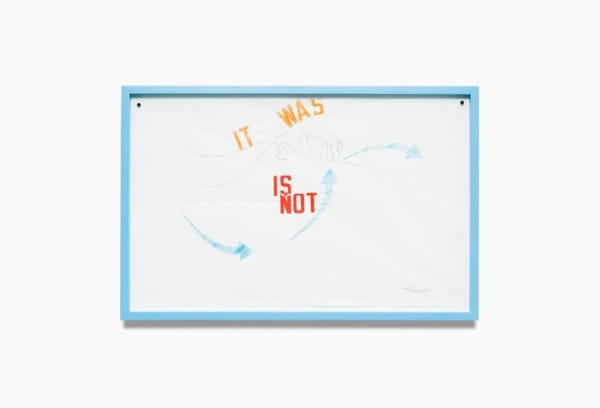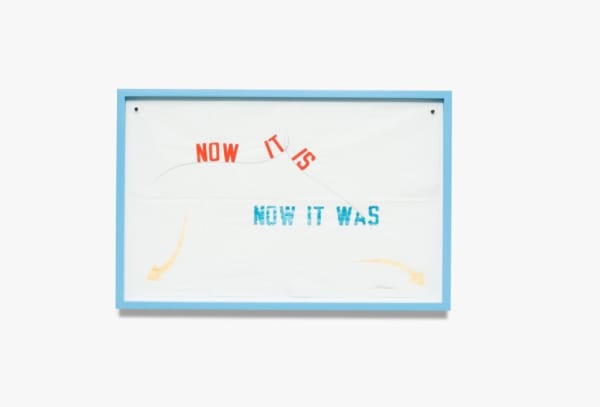Somewhere São Paulo Lawrence Weiner
Past exhibition
Overview
In the São Paulo metropolis, there are no historical traditions that can fully guarantee a relation between the buildings, their contexts and meanings. Thus, what happened to the oldest – and most significant – monument in São Paulo’s history, the bicentenary Obelisco da Memória (Memory Obelisk), is symptomatic. Its task ended up being lost throughout the centuries and, today, no one is sure of what the obelisk is supposed to remind us of. There are, of course, several hypotheses, but the fact remains that the monument that could have played a leading role – become a prominent subject – in the city’s history turned into a mere connection between an ever-changing present and an indistinct past. Maybe this was the obelisk’s most fitting destiny, but its name might as well have been changed to Oblivion Obelisk, or, as Lawrence Weiner would have it, Ipso Facto Monument.
Ipso facto, by the fact itself: the monument’s message was reduced to its own existence, and to the metaphors that we can elaborate about it. There is a striking coincidence between the nature of São Paulo’s construction and some of Lawrence Weiner’s statements. It so happens that in the city’s landscape, there is an abundance of passageway elements rather than the few places that have effectively consolidated themselves as landmarks. With an urge for novelty, the frailty of the urban growth planning sooner or latter interrupts buildings and neighborhoods’ life cycles, leaving behind incomplete meanings and identities. If this city were to be compared to a book, maybe it would be like one of those stream of consciousness writings, in which punctuation marks such as commas, colons, and dashes are far more abundant than periods.
More often than not, Lawrence Weiner’s drawn verbal attitudes in urban spaces – his statements/sculptures – act as this kind of accompaniment to their context. It is like Weiner put it in 1968, when he constructed an outdoor piece at Windham College: The idea of building a piece of sculpture outdoors has always intrigued me... I’d liken it to walking in the woods, when you come upon a gravestone half buried. Now, if a piece of sculpture can exist within a landscape in that sense, whatever is around the landscape is heightened and brought out. It’s a matter of what you can displace with what you are doing to the place.
Back then, the artist had displaced materials like staples, stakes, twine and turf; thereafter he has mostly been dealing with extremely concise textual formulas that still manage to heighten their surroundings. The same happens in the interventions proposed by Weiner at the streets of the Jardins neighborhood, on façades and manholes along the route between Mendes Wood DM and Luisa Strina art galleries. Maybe the most emblematic one is the ~ & ~ painted on one of the manhole covers; it is an element that infiltrates the streets’ information flow, but doesn’t say anything specific, acting as a connector between whatever was seen or thought of by the pedestrians immediately before and after running into it. It works as a comma in the long sentence that is formed while we walk around the city. Moreover, this connectivity effect also happens when we come across the statements placed on two façades: HERE FOR A TIME THERE FOR A TIME & SOMEWHERE FOR A TIME; this equation suggests the displacement of something, in time and space, that remains undetermined.
It must be noted that Weiner’s works provoke, whether in books, exhibition spaces or on the streets, a peculiar relation between presence and absence. They don’t try to be totally indifferent to the places they occupy, as it would be expected from them if they followed conceptual art’s orthodox jargon; nor do they formally respond to the spaces’ proportions and forms, as textbook site-specific initiatives would require.
His phrasal constructs update the way we feel about existing spaces, as well as delineate their own spatiality. There are times when his works emphasize presence: when reading A HANDFUL OF DUST LEFT BEHIND, we immediately realize this idea using our imagination. In other occasions, the statements invite the readers to picture a space that’s only been evoked: THROWN INTO DISARRAY BENEATH THE SURFACE, for example, has enough connotations to make us think that it could be referring to ourselves or to other people, right here or somewhere else – thus, the sentence throws us into a cycle of projections and reflections.
In this endless game, Lawrence Weiner ends up teaching us that art always exists within a certain space, but that it shouldn’t necessarily limit itself to following the evident spatial features. After all, the way through which we apprehend spaces is, in itself, conditioned by language – even if the lexicon at stake doesn’t actually belong to those particular contexts. If Lawrence Weiner’s books have already been shown in an exhibition called Learn to Read Art (New York Public Library, 1995), in São Paulo, his language sculptures could very well be the starting point of a research called Learn to Read the Metropolis.
– Paulo Miyada
Ipso facto, by the fact itself: the monument’s message was reduced to its own existence, and to the metaphors that we can elaborate about it. There is a striking coincidence between the nature of São Paulo’s construction and some of Lawrence Weiner’s statements. It so happens that in the city’s landscape, there is an abundance of passageway elements rather than the few places that have effectively consolidated themselves as landmarks. With an urge for novelty, the frailty of the urban growth planning sooner or latter interrupts buildings and neighborhoods’ life cycles, leaving behind incomplete meanings and identities. If this city were to be compared to a book, maybe it would be like one of those stream of consciousness writings, in which punctuation marks such as commas, colons, and dashes are far more abundant than periods.
More often than not, Lawrence Weiner’s drawn verbal attitudes in urban spaces – his statements/sculptures – act as this kind of accompaniment to their context. It is like Weiner put it in 1968, when he constructed an outdoor piece at Windham College: The idea of building a piece of sculpture outdoors has always intrigued me... I’d liken it to walking in the woods, when you come upon a gravestone half buried. Now, if a piece of sculpture can exist within a landscape in that sense, whatever is around the landscape is heightened and brought out. It’s a matter of what you can displace with what you are doing to the place.
Back then, the artist had displaced materials like staples, stakes, twine and turf; thereafter he has mostly been dealing with extremely concise textual formulas that still manage to heighten their surroundings. The same happens in the interventions proposed by Weiner at the streets of the Jardins neighborhood, on façades and manholes along the route between Mendes Wood DM and Luisa Strina art galleries. Maybe the most emblematic one is the ~ & ~ painted on one of the manhole covers; it is an element that infiltrates the streets’ information flow, but doesn’t say anything specific, acting as a connector between whatever was seen or thought of by the pedestrians immediately before and after running into it. It works as a comma in the long sentence that is formed while we walk around the city. Moreover, this connectivity effect also happens when we come across the statements placed on two façades: HERE FOR A TIME THERE FOR A TIME & SOMEWHERE FOR A TIME; this equation suggests the displacement of something, in time and space, that remains undetermined.
It must be noted that Weiner’s works provoke, whether in books, exhibition spaces or on the streets, a peculiar relation between presence and absence. They don’t try to be totally indifferent to the places they occupy, as it would be expected from them if they followed conceptual art’s orthodox jargon; nor do they formally respond to the spaces’ proportions and forms, as textbook site-specific initiatives would require.
His phrasal constructs update the way we feel about existing spaces, as well as delineate their own spatiality. There are times when his works emphasize presence: when reading A HANDFUL OF DUST LEFT BEHIND, we immediately realize this idea using our imagination. In other occasions, the statements invite the readers to picture a space that’s only been evoked: THROWN INTO DISARRAY BENEATH THE SURFACE, for example, has enough connotations to make us think that it could be referring to ourselves or to other people, right here or somewhere else – thus, the sentence throws us into a cycle of projections and reflections.
In this endless game, Lawrence Weiner ends up teaching us that art always exists within a certain space, but that it shouldn’t necessarily limit itself to following the evident spatial features. After all, the way through which we apprehend spaces is, in itself, conditioned by language – even if the lexicon at stake doesn’t actually belong to those particular contexts. If Lawrence Weiner’s books have already been shown in an exhibition called Learn to Read Art (New York Public Library, 1995), in São Paulo, his language sculptures could very well be the starting point of a research called Learn to Read the Metropolis.
– Paulo Miyada
Works
-
 Lawrence Weiner, HERE FOR A TIME AQUI POR UM TEMPO THERE FOR A TIME LÁ POR UM TEMPO & SOMEWHERE FOR A TIME EM ALGUM LUGAR POR UM TEMPO, 2014
Lawrence Weiner, HERE FOR A TIME AQUI POR UM TEMPO THERE FOR A TIME LÁ POR UM TEMPO & SOMEWHERE FOR A TIME EM ALGUM LUGAR POR UM TEMPO, 2014 -
 Lawrence Weiner, UM PUNHADO DE PÓ DEIXADO PARA TRÁS A HANDFUL OF DUST LEFT BEHIND, 2014
Lawrence Weiner, UM PUNHADO DE PÓ DEIXADO PARA TRÁS A HANDFUL OF DUST LEFT BEHIND, 2014 -
 Lawrence Weiner, THROWN INTO DISARRAY BENEATH THE SURFACE ATIRADO EM DESORDEM SOB A SUPERFICIE, 2014
Lawrence Weiner, THROWN INTO DISARRAY BENEATH THE SURFACE ATIRADO EM DESORDEM SOB A SUPERFICIE, 2014 -
 Lawrence Weiner, IS NOT, 2014
Lawrence Weiner, IS NOT, 2014 -
 Lawrence Weiner, NOW IT WAS, 2014
Lawrence Weiner, NOW IT WAS, 2014 -
 Lawrence Weiner, THE TIRANNY OF SINTAX, 2014
Lawrence Weiner, THE TIRANNY OF SINTAX, 2014
Installation Views







